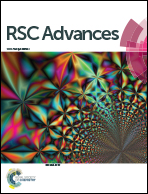Targeting the heme proteins hemoglobin and myoglobin by janus green blue and study of the dye–protein association by spectroscopy and calorimetry†
Abstract
The binding of the phenazinium dye janus green blue (JGB) to two heme proteins, hemoglobin (Hb) and myoglobin (Mb), was studied by biophysical and microcalorimetry techniques. Ground state complex formation was ascertained from absorbance and fluorescence data. The binding affinity of JGB to myoglobin was higher than that to hemoglobin. The dye induced conformational changes in the proteins as revealed from circular dichroism, synchronous fluorescence and 3D fluorescence results. The binding was characterized in calorimetry by endothermic heats. The negative standard molar Gibbs energy in both cases suggested the spontaneity of the reaction. The positive enthalpy and positive entropy changes characterized the binding of the dye to the proteins. The higher affinity to Mb (K = 8.21 × 104 M−1) over Hb (K = 6.60 × 104 M−1) was confirmed from calorimetry results. The binding involved contribution from both polyelectrolytic and non-polyelectrolytic forces. pH dependent studies confirmed the involvement of ionic interactions in the complexation. The molecular details of the interaction in terms of structural aspects and energetics are described.


 Please wait while we load your content...
Please wait while we load your content...